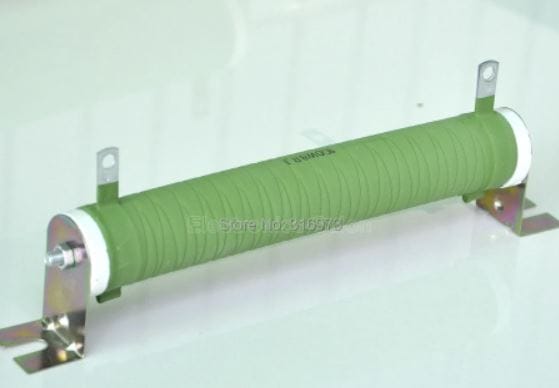
- Testing the output of an amplifier is usually a bench test. This means it's done in the shop prior to installation.
- Occasionally though, a problem can come up in the field. It's handy to be able to check an amp channel there, but it is involved.
- The particular problem is with a high power amplifier. You need to have a load resistor which exceeds the rated power of the amp.
- Load resistors can be easily purchased and most are not expensive. Be sure to look for an non-inductive 8 ohm resistor. Do not use a resistor rated less than the power output of the amp.
- First, disconnect all speakers from the amp. Make sure the amp is Off. DO NOT RUN THE TEST ON AN AMP WITH ANY SPEAKER STILL CONNECTED!
- Care must be taken to avoid overdriving any speaker or shorting any connections.
- Use the same TRS to Alligator clip cable used for the impedance test to connect to the load resistor to the Input of the iAI2. Polarity is not important.
- Now connect the speaker output of channel in question to the load resistor.
- Turn on the amp or AVR with gain at 0. It should be connected via HDMI to your Apple TV. Switch to that input.
- Back on the HAA app, select the Optional Amplifier Test. You'll see the oscilloscope feature.
- Tap the Sine Wave Icon to see the test tone box. Select Sine with a frequency of 1000 Hz. Make sure it's at 1000 Hz.
- Use Apple Air Play (screen mirroring) to switch the Apple TV to the iPads screen. It should now appear on your display.
- Turn on the oscilloscope test tone with the switch located in the test tone box where it says 1000 Hz.
- Turn up the gain on your AVR/Pre-amp. You won't hear anything but you'll know the signal is going to the amp by the oscilloscope displaying a sine wave.
- Turn the AVR gain up until the sine wave begins clipping (the crest of the sine wave flattens)
- Note the wattage (at the bottom left corner of the oscilloscope chart). The power output of the channel will be just before the sine wave clips. LIMIT THE DURATION OF EACH TEST TO AVOID HEATING UP THE LOAD RESISTOR
- This test is just a spot check of the channel for troubleshooting. Be aware that the true power output of the amplifier requires all channels to be driven
- A check of multiple channels should show they have the same output to conclude the channel is functioning normally.

